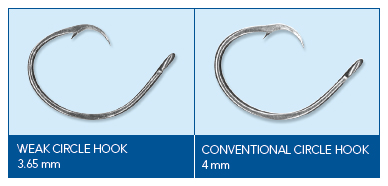A 'Weak' Solution
 The National Marine Fisheries Service (NMFS) issued a final rule in April 2011 designed to help protect spawning bluefin tuna in the Gulf of Mexico. This rule requires commercial surface longline fishermen to use an experimental “weak” hook when fishing for yellowfin tuna and swordfish in the Gulf. The diameter of the experimental hook is smaller than a conventional circle hook. Under the right conditions, the weight of a large bluefin could straighten it and allow it to escape.
The National Marine Fisheries Service (NMFS) issued a final rule in April 2011 designed to help protect spawning bluefin tuna in the Gulf of Mexico. This rule requires commercial surface longline fishermen to use an experimental “weak” hook when fishing for yellowfin tuna and swordfish in the Gulf. The diameter of the experimental hook is smaller than a conventional circle hook. Under the right conditions, the weight of a large bluefin could straighten it and allow it to escape.
Unfortunately, even large bluefin may be so fatigued by high water temperatures, spawning activities and other factors that they are unable to straighten the hooks and get away. Hooked bluefin could also be attacked by predators and removed from the line before fishermen could count them.
The real-world performance of weak hooks is also affected by other variables, such as the depth at which surface longlines are fished, the number of hooks between floats, the distance between floats, how fishermen haul in lines, the currents and water temperatures. These factors interfere with the performance of weak hooks and add uncertainty to their efficacy. Weak hook experiments have not proved that bycatch mortality (the number of bluefin killed by surface longlines) decreases, just the number of bluefin hauled back to the boat.
More Bent Hooks and Fewer Swordfish
Although weak hooks are designed to release large bluefin, large swordfish and yellowfin tuna could potentially straighten a weak hook, too. Research also indicates that the catch rates for undersize swordfish could be higher for the experimental hook than conventional circle hooks. Federal regulations require all undersize swordfish to be thrown back, dead or alive.
NMFS and the commercial fishing industry are trying to find ways to catch more of the swordfish quota allocated to the United States under an international agreement. This task could be made much more difficult by the widespread use of weak hooks capable of releasing large, valuable swordfish and catching more undersize—and discarded— swordfish.
Weak Hooks Need Strong Data
Validating the effectiveness of these hooks at releasing spawning bluefin while still alive will require much more on-the-water research using hook timers and time depth recorders. These devices measure when the fish are hooked and how long they stay hooked. Without this information, it is impossible to accurately estimate the reduction in the amount of bluefin killed by surface longlines.
NMFS's Gulf weak hook research tested only 198,606 hooks, half weak and half standard, from 2008 through 2010. When NMFS required surface longline fishermen to use circle hooks in June 2004, the agency based its decision on multiple studies and a total of 1.2 million hooks fished. Much more scientific research is necessary to validate the efficacy of the hooks.
Even if extensive research validates this new hook, implementing it will present challenges. When used in large numbers, weak hooks are almost indistinguishable from the standard circle hook used by the Gulf longline fleet. Standard hooks are 4 mm steel wire, and the weak hooks are 3.65 mm steel wire. Each surface longline carries approximately 1,000 hooks, making it difficult for enforcement officials to inspect thoroughly. State and federal agencies responsible for enforcing fishery regulations in the Gulf already face budget shortfalls and lack sufficient funding to support enforcement operations. The weak hook rule would merely place another burden on underfunded agencies.
If fishermen lose target species, such as swordfish, they will have little incentive to comply with the new regulation when fishing.
Finally, to make up for a loss of target species, the fishermen could increase the amount of time they spend fishing or with hooks in the water. NMFS has no tools in place to guard against this. If it did happen, the conservation benefit of using weak hooks could be offset by the increased amount of fishing.
A Reliable Solution
Based on NMFS research, the weak hook will not reliably protect spawning western Atlantic bluefin tuna from being killed by indiscriminate surface longline gear. In contrast, actively tended gear, such as green stick and buoy gear, is more selective, offering sound alternatives to indiscriminate surface longlines and unproven weak hooks.
Take Action Today
Please visit www.PewEnvironment.org/GulfTuna to tell Dr. Jane Lubchenco, administrator of the National Oceanic and Atmospheric Administration, to facilitate the transition from surface longlines to more selective fishing gears in the Gulf of Mexico.
To view citations, please download the PDF of this fact sheet.






